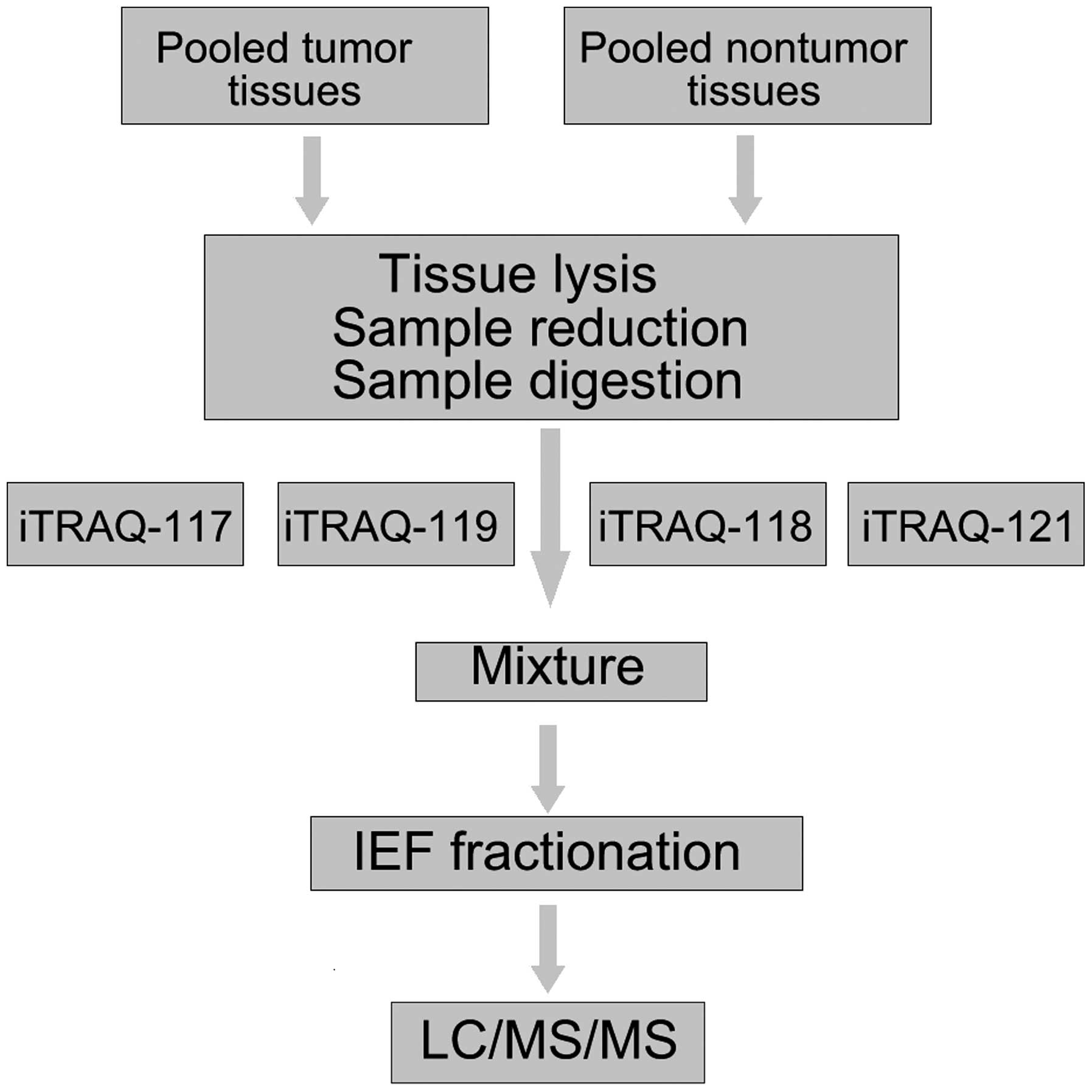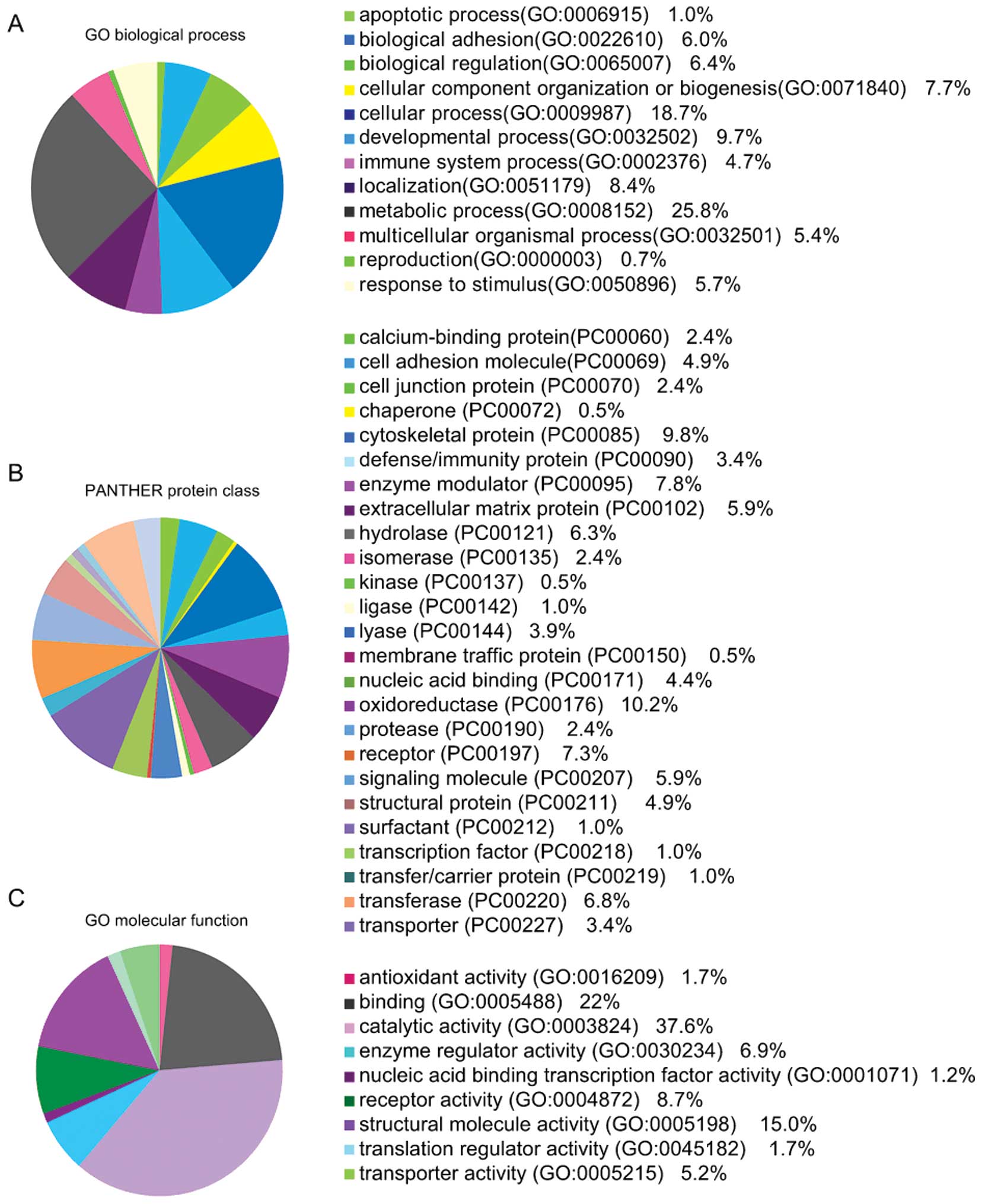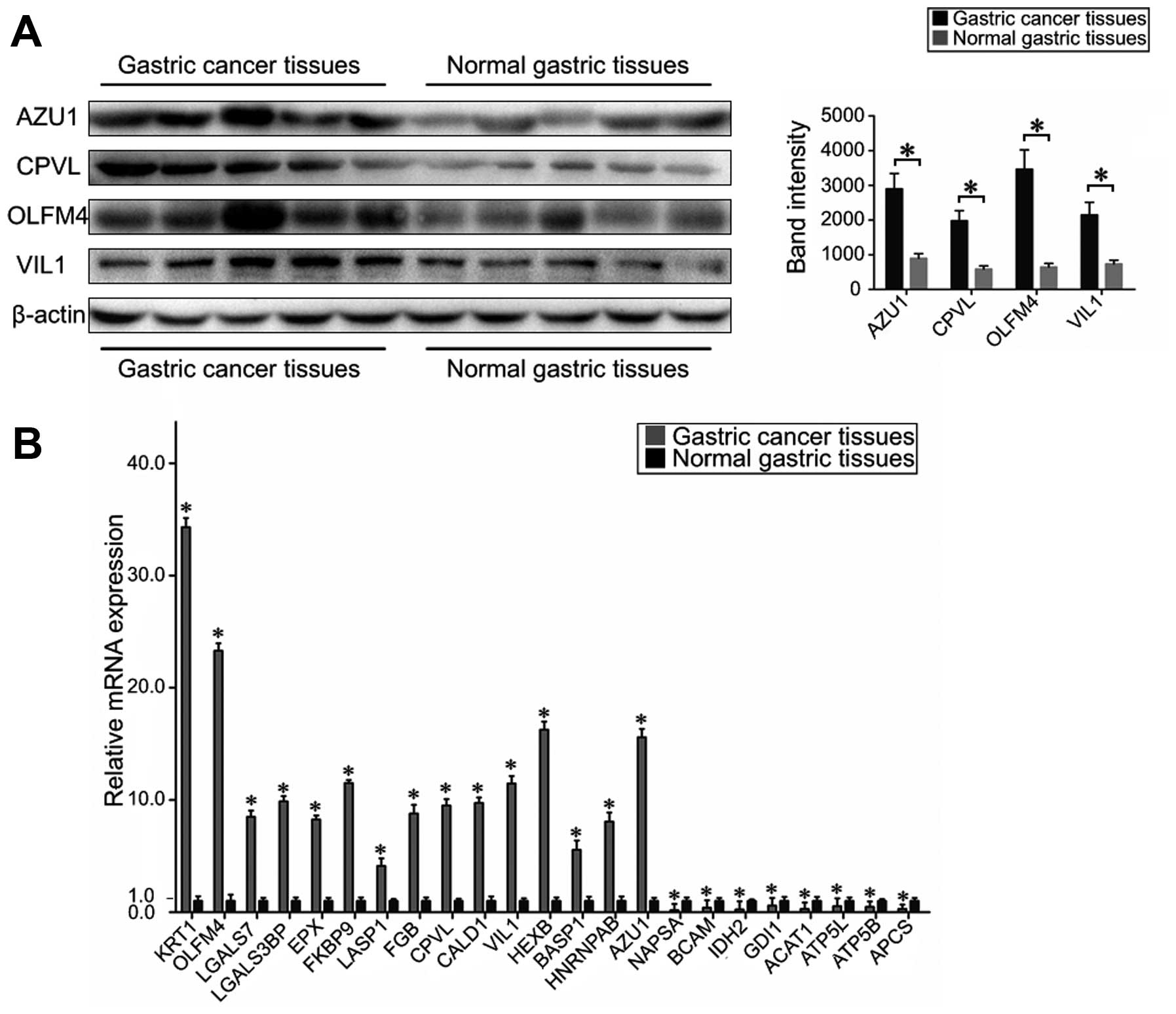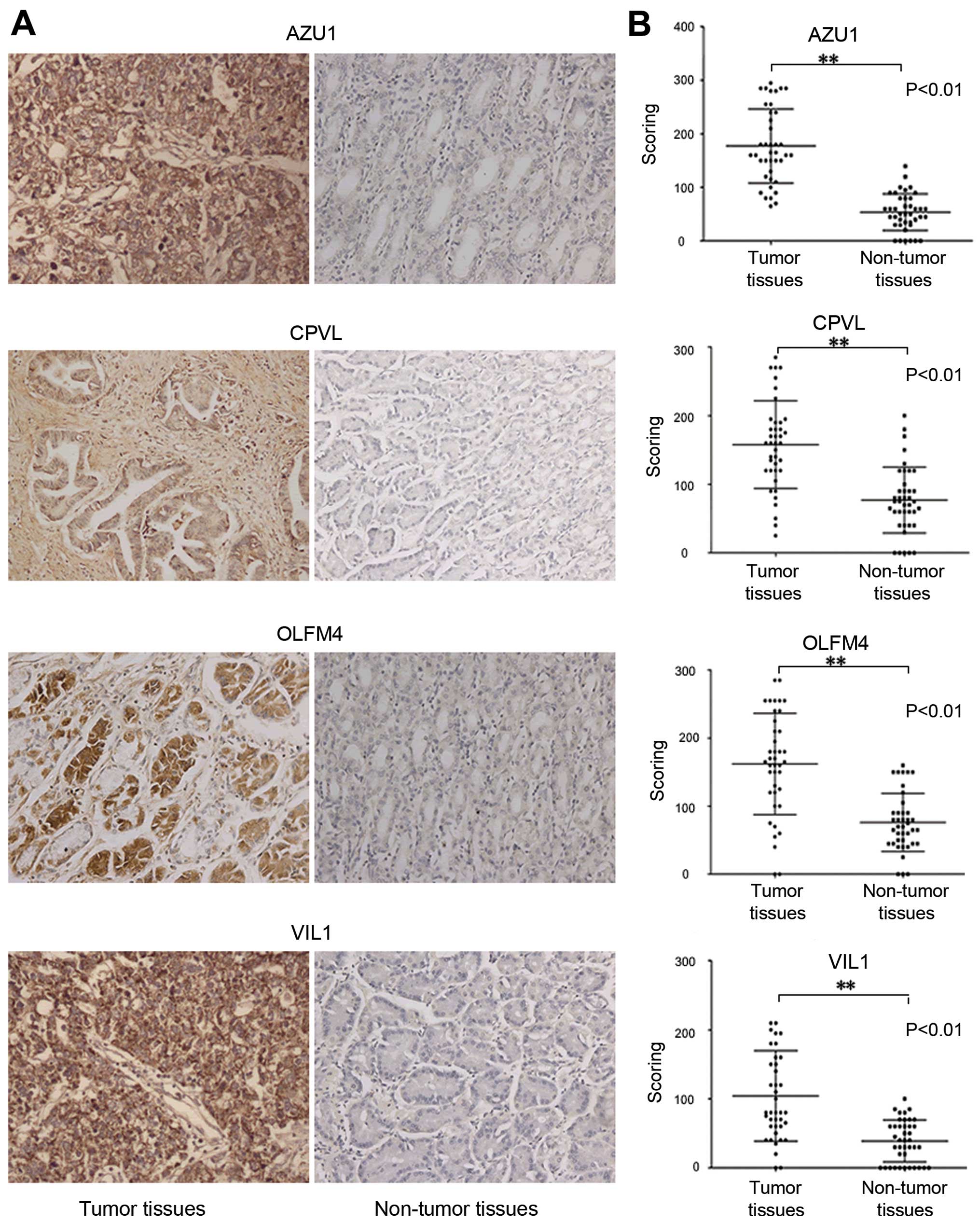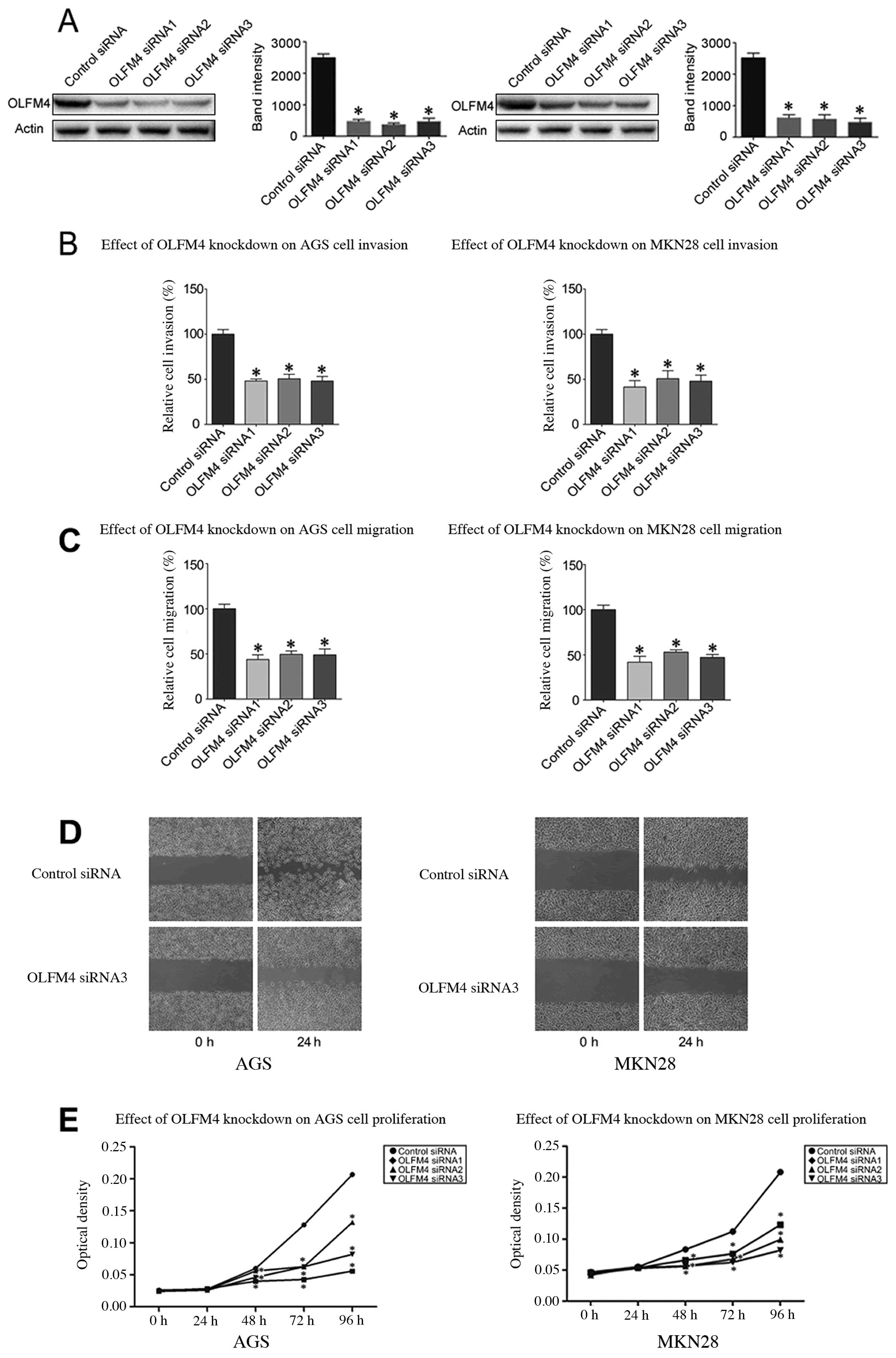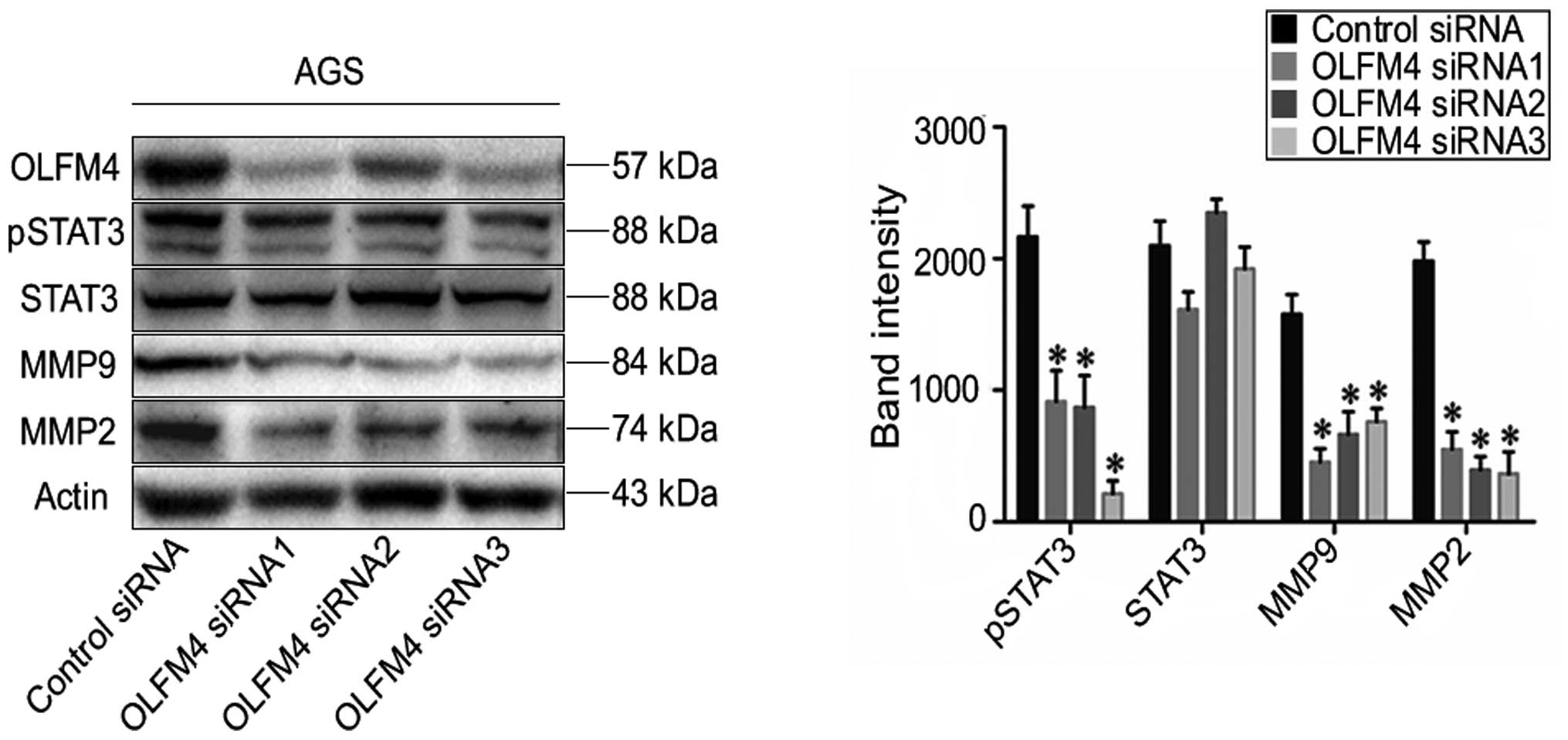A quantitative proteomics study on olfactomedin 4 in the development of gastric cancer
- Authors:
- Published online on: September 16, 2015 https://doi.org/10.3892/ijo.2015.3168
- Pages: 1932-1944
Abstract
Introduction
Gastric cancer (GC) is the fifth most common cancer in the world, following lung, breast, prostate and colorectal cancers, with an estimated 952,000 newly reported cases and 723,000 related deaths in 2012. Of these new cases, more than 70% occurred in less developed regions, with 50% occurring in Eastern Asia (mainly in China) (1). The depth of wall invasion, local lymph node and distal organ invasion, which are found with tumor-metastasis in the clinical staging systems, are evaluated for GC diagnosis and prognosis. A 5-year survival rate of >90% has been observed for patients diagnosed with early gastric cancer, whereas the survival rate is only 5% for those diagnosed with GC with synchronous distant metastasis (2). The mechanism of metastasis is still unknown. Therefore, investigating the molecular mechanism of gastric cancer metastasis could provide insights to improve diagnosis and therapeutic approaches.
In recent years, proteomics analysis has provided us with a powerful, global tool to study and evaluate protein expression. Two-dimensional gel electrophoresis (2-DE) was widely used in proteomics-based approaches, which has been traditionally performed in order to identify the cancer-related protein (3). However, 2-DE is a labor-intensive method which is insensitive to the detection of low-abundance protein and hydrophobic membrane proteins. Both limited sample capacity and low linear visualization range are its disadvantages (4). Nowadays, isotope-based quantitative proteomics is widely used in the identification and quantification of proteins, such as isobaric tags for relative and absolute quantitation (iTRAQ) (5), ICAT (6), 18O (7) and SILAC (8). Among these techniques, the iTRAQ method is an MS/MS-based technique which enables both protein identification and relative quantification in a multiplexed experiment.
In the present study, we used the quantitation of the proteomics method to analyze the differences of protein expression levels between gastric cancer and normal gastric tissues. Among these proteins, we focused on olfactomedin 4 (OLFM4) because this protein has recently been shown to be aberrantly expressed in malignancies. Furthermore, the study on the function of OLFM4 in gastric cancer had not been previously reported. We further studied the biological function of GC cells silencing OLFM4 expression, in an attempt to determine whether the overexpression of this protein is relevant to the malignancy of gastric cancer.
Materials and methods
Patients and cell lines
Fifteen patients with gastric cancer were included in this study (Table I). In our clinical patients, a majority of GC patients had neoplasms of intermediate differentiation (stage III or IV). The patients were selected from gastric cancer patients from the Second Affiliated Hospital of Chongqing Medical University. Gastric cancer tissues and adjacent non-cancer gastric tissue were used for iTRAQ-coupled LC-MS/MS analyses. Non-cancer tissues were obtained from the distal edge of the resection at least 10 cm from the tumor. The study was approved by the Ethics Committee of Chongqing Medical University and all patients signed written informed consent prior to participation in the present study. Two human gastric cancer cell lines (AGS and MKN28) from ATCC were grown in RPMI-1640 medium supplanted with 10% fetal bovine serum (FBS; Gibco, San Diego, CA, USA) and penicillin and incubated in an atmosphere of 5.0% carbon dioxide at 37°C.
Protein digestion and peptide iTRAQ labeling
The 8-plex iTRAQ kits were obtained from Applied Biosystems (Foster City, CA, USA). All the proteins were extracted using a Sample Grinding kit obtained from Amersham Biosciences with lysis buffer which contains 7 M urea, 1 mM PMSF, 1 mM Na3VO4 and 1 mg/ml DNase I. After being centrifuged at 15,000 rpm for 15 min at 4°C (9), the supernatant liquid was collected, then the protein concentrations were quantified by the 2D Quantification kit. Approximately 100 μg of protein from each sample were further precipitated with ice-cold acetone at −20°C overnight and dissolved with a denatured lysis buffer. According to the manufacturer's instrument (Applied Biosystems, Framingham, MA, USA), the cysteines were then blocked. Each sample was digested to peptides using 20 μl of 0.1 μg/μl sequencing grade modified trypsin (Promega) solution at 37°C overnight. Labeling was as follows with different isobaric tags: i) gastric cancer tissues, 117 and 119 tags; and ii) normal gastric tissues, 118 and 121 tags. Prior to fractionation of peptides, the labeled samples were placed at room temperature for 1 h and combined.
Peptide fractionation
The pooled iTRAQ-labeled samples were solubilized in 300 μl of 1% Pharmalyte (Amersham Biosciences) and 8 M urea. Samples were used to rehydrate 18 cm-long IPG gel strips (pH 3–10; Amersham Biosciences) at 30 V for 14 h. Electrofocusing of the peptides was carried out successively at 500 V for 1 h, 1000 V for 1 h, 3000 V for 1 h and 8000 V for 8.5 h to reach a final level of 68 kV•h. After focusing, the strips were withdrawn and sliced into 36 sections of 5 mm thickness. Peptides were extracted by incubating the gel pieces in 100 μl of 2% acetonitrile, 0.1% formic acid for 1 h (10). The pieces were purified and concentrated on a C18 Discovery DSC-18 SPE column (Sigma-Aldrich), then lyophilized and maintained at −20°C (10). Just prior to LC-MS/MS analysis, the samples were resuspended in 20 μl of Buffer A (0.1% formic acid in 2% acetonitrile).
Mass spectrometry and database search
The samples were analyzed using a QStar Elite mass spectrometer (Applied Biosystems) coupled with an Dionex UltiMate 3000 liquid chromatography system (Amsterdam, The Netherlands) (9,10). For each analysis, samples were loaded onto a C18 PepMap column (Dionex) at a flow rate of 300 nl/min. A 125-min gradient was generated between Buffer A and Buffer B (98% ACN, 0.1% FA), and consisted of 3 min of both 4% Buffer B and 96% Buffer A, 7 min of 4–10% Buffer B, 55 min of 10–35% Buffer B, 25 min of 35–100% Buffer B, 15 min of 100% Buffer B and a final 20 min of 96% Buffer A (10). The mass spectrometer was set to perform data acquisition in the positive ion mode, with a selected mass range of 300–1800 m/z. The two most abundant charged ions which exceeded 20 counts were chosen for MS/MS and dynamically excluded for 30 sec with a ±50 mDa mass tolerance (10).
ProteinPilot software (version 2.0; Applied Biosystems, MDS-Sciex) was used for protein identification and quantification. MS/MS data were searched against the International Protein Index (IPI) human database v3.77. The database was searched by setting a fixed modification of cysteine using MMTS. Other parameters included oxidation of methionine, iTRAQ labeled-lysine, N-terminal iTRAQ labeling, MS/MS tolerance: 0.5 Da, and a maximum of one missed cleavage. The relative quantification of each peptide in the case of iTRAQ was determined on the MS/MS scans using the peak areas of 117, 118, 119 and 121 Da. The Paragon Algorithm embedded in ProteinPilot V2.0 software was used for the statistical calculation. In brief, protein identification was based on 3 or more unique peptides, of >95% confidence, being assigned.
RNA extraction and quantitative RT-PCR
Total RNA was extracted with a Trizol reagent (Gibco-BRL, Gaithersburg, MD, USA) according to the manufacturer's instructions. First-strand cDNA was synthesized from 2 μg of total RNA, using A3500 Reverse transcription system (Promega). RT-PCR was performed on an ABI 7900HT system using the Taq-Man Gene Expression Assay kit and following primers for GAPDH (Hs00486019_CE), NAPSA (Hs00188200_CE), KRT1 (Hs00459308_CE), BCAM (Hs00185951_CE), OLFM4 (Hs00447959_CE), LGALS7 (Hs00355547_CE), LGALS3BP (Hs00417610_CE), IDH2 (Hs00475823_CE), GDI1 (Hs00401968_CE), EPX (Hs00169490_CE), FKBP9 (Hs00405072_CE), HNRNPAB (Hs00269605_CE), LASP1 (Hs00348599_CE), FGB (Hs00255169_CE), CPVL (Hs00507250_CE), ACAT1 (Hs00111889_CE), CALD1 (Hs00372592_CE), ATP5L (Hs00334349_CE), BASP1 (Hs00258102_CE), ATP5B (Hs00481655_CE), APCS (Hs00289738_CE), VIL1 (Hs00206299_CE) and AZU1 (Hs00177715_CE). Relative expression was calculated according to the 2−ΔΔCT quantification method (11).
Immunoblot analysis
The cells/tissues were lysed for 30 min at 4°C in a non-ionic detergent (NID) lysis buffer containing 1 mM, pH 8.0 EDTA, 0.5% IGEPAL, 50 mM, pH 7.5 Tris-HCl, 50 mM sodium fluoride, 150 mM NaCl, 1 mM sodium orthovanadate, 0.5% Triton-X and protease inhibitors (11). Approximately 20 μg of the protein specimens were separated with the use of SDS-polyacrylamide and transferred onto PVDF membranes (Amersham Biosciences). After blocking with 5% non-fat powdered milk in TBS-T buffer (pH 7.6, 0.5% Tween-20), the monoclonal antibodies against Azurocidin 1 (AZU1), CPVL, OLFM4, Villin 1 (VIL1), transducer and activator of transcription 3 (STAT3), phosphorylated STAT3 (pY705-STAT3), matrix metalloproteinase 9 (MMP9), matrix metalloproteinase 2 (MMP2), and actin from Abcam (Cambridge, MA, USA) were incubated at a dilution of 1:500–1:1,000 at normal temperature for 2 h. A horseradish peroxidase-conjugated goat anti-mouse IgG or goat anti-rabbit IgG (Amersham Biosciences) was incubated at a dilution of 1:5,000 for 1 h at room temperature. All of the blots were developed by the enhanced chemiluminescence (ECL) system obtained from Amersham Biosciences (Uppsala, Sweden).
Immunohistochemistry (IHC) and tissue microarrays (TMA)
The tissue microarrays (LV801a) obtained from US Biomax Inc. (Rockville, MD, USA) contain formalin-fixed paraffin embedded samples of 40 cases of gastric cancer and 40 matched or unmatched cancer adjacent normal, single core tissues. Immunohistochemistry of TMA was carried out as previously reported (12). After dewaxing with xylene, sections were rehydrated using an alcohol gradient (100, 95 and 70%) and finally washed in double-distilled H2O (12). After quenching endogenous peroxidase activity with 3% H2O2 for 10 min and blocking with BSA for 30 min, the sections were incubated with antibodies against AZU1, CPVL, OLFM4, and VIL1 (1:100) overnight at 4°C. Detection was achieved with the Envision/horseradish peroxidase system (DakoCytomation, Glostrup, Denmark) (12). All slides were counterstained with Gill's hematoxylin for 1 min, dehydrated and mounted for light microscope analysis (10,12).
The stained TMA slides were evaluated and scored by the same certified pathologist who was blinded to the clinical data. The protein expression was assessed using a semi-quantitative scoring consisting of an assessment of both staining intensity (scale 0–3) and the percentage of positive cells (0–100%), which, when multiplied, generate a score ranging from 0 to 300. The t-test was performed at 95% confidence. All the statistical analyses were performed using SPSS software for Windows, version 16.0 (SPSS, Inc., Chicago, IL, USA).
OLFM4 siRNA transfection, wound-healing, cell migration and invasion assays
AGS and MKN28 cells were transfected with negative control siRNA (12935-400) or 100 nM of OLFM4 specific Stealth Select RNAi™ siRNA (HSS116245, HSS116246 and HSS116247) using Lipofectamine 2000 according to the manufacturer's protocol (Invitrogen-Life Technologies, Carlsbad CA, USA). Two days following transfection, wound-healing, cell migration and invasion assays were conducted. The wound healing assay was performed in 6-well plates. When the cells had grown to confluence, a wound was incised in the cell monolayer using a sterile p200 pipette tip. Images of the scratches were captured at 0 and 24 h using a phase contrast microscope. The rate of cell migration was determined by the extent of gap closure. The transwell migration and invasion assays were performed using a 24-well cell migration and invasion assay kit (8 μm pore size, colorimetric format) obtained from Cell Biolabs Inc. (San Diego, CA, USA) according to the manufacturer's protocol. Briefly, after being transfected with OLFM4 or control siRNA for 48 h and starved for 24 h, AGS and MKN cells were harvested and resuspended in serum-free media. Approximately 3×105 cells/300 μl media were loaded into the upper chamber, and the lower chambers were filled with 500 μl media (1640 plus 10% FBS). Cells were allowed to migrate or invade for 12 or 24 h, respectively. The non-invasive cells on the top of the Transwell membrane filter inserts were removed with cotton swabs, while the migrating/invading cells on the bottom of the filters were stained, fixed, extracted, and measured at OD 560 nm according to the manufacturer's instructions. In each case, the silencing of protein expression was verified by western blot analysis as described above.
Cell proliferation assay
AGS and MKN28 cells were seeded onto 96-well plates at a density of 1.5×103 cells/well. Cells were cultured in RPMI-1640 media with 10% FBS and transfected with OLFM4 siRNA or control siRNA for 0, 24, 48, 72 and 96 h at 37°C. The MTT assay wad performed as follows: cells were incubated with 20 μl MTT (Sigma-Aldrich) at 37°C for 4 h. The MTT substrate was then dissolved in 200 μl of DMSO (Sigma-Aldrich) for 5 min. Finally the absorbance was measured at 570 nm.
Statistical analysis
All experiments were performed at least in triplicate. The data were plotted as mean ± standard deviation (SD) and performed with the Student's t-test between the two groups. A P-value of <0.05 was considered statistically significant.
Results
Analysis of iTRAQ data of aberrantly expressed proteins
We used the iTRAQ quantification to investigate the mechanism of GC. The ITRAQ assay was performed on pooled tumor tissues and pooled non-tumor tissues. To improve the confidence and enhance the range of protein identification, specimens were iTRAQ labeled in duplicate. Fig. 1 shows the flow chart of iTRAQ proteomics approach. The ratio of 117:118 and 119:121 expressed the relative protein expression in the GC tissues compared to non-cancer tissues, which were used as a control group.
For protein quantitation and identification, we used ProteinPilot 2.0 software to identify hundreds of proteins. The protein threshold was set to achieve 95% confidence at 5% FDR (false discovery rate). To classify proteins as upregulated or downregulated, we introduced an additional 1.3-fold cut-off for all iTRAQ ratios (10,13–16). Therefore, proteins with iTRAQ ratios <0.77 (1/1.3) or >1.3 (1.3/1)-fold cut-off (P<0.05) were considered to be downregulated or upregulated, respectively (13,17). The technical variation of data from duplicate experiments was <30% (12,14,18–21). A total of 753 unique proteins were identified with 95% confidence, regardless of whether or not there was a significant P-value in the iTRAQ ratios. A total of 134 proteins were expressed differently in gastric cancer compared to non-cancer tissues (51 overexpressed and 83 downregulated proteins). Due to limitations of space, only the top 30 downregulated and upregulated proteins in both pooled non-cancer tissues and pooled cancer tissues are shown in Table II.
Table IIPartial list of proteins found to be expressed at different levels between gastric cancer and non-cancer tissues by iTraq analysis.a |
Cellular and molecular functional characteristics of the proteins
To better identify the functional characteristics, the 134 aberrantly expressed proteins were uploaded into PANTHER (www.pantherdb.org/) and grouped on the basis of their reported biological processes and molecular functions.
The identities of a total of 134 proteins and their molecular functions are shown in Fig. 2, which include 12 biological processes, 25 protein classes and 9 molecular functions. Metabolic, cellular and developmental processes were the most common biological processes reported.
Validation of iTRAQ identified candidate proteins
To validate the observed protein changes, western blotting and RT-PCR were performed with identical pooled cancer samples and non-cancer samples used in the iTRAQ assay. Fig. 3A shows that AZU1, CPVL, OLFM4 and VIL1 were obviously increased in the gastric cancer tissues, compared with normal gastric tissues. Although each immunoblot had its own control, only one representative actin blot is shown. Fig. 3B shows the mRNA expression levels of NAPSA, KRT1, BCAM, OLFM4, LGALS7, LGALS3BP, IDH2, GDI1, EPX, FKBP9, HNRNPAB, LASP1, FGB, CPVL, ACAT1, CALD1, ATP5L, BASP1, ATP5B, APCS, VIL1, AZU1 and HEXB as standardized to GADPH. As expected, the mRNA levels of KRT1, OLFM4, LGALS7, LGALS3BP, EPX, FKBP9, LASP1, FGB, CPVL, CALD1, VIL1, HEXB, BASP1, AZU1 and HNRNPAB were found to be increased in gastric cancer tissues, whereas the levels of NAPSA, BCAM, IDH2, GDI1, ACAT1, ATP5L, ATP5B and APCS were decreased, compared to non-cancer tissues. These results correspond with that revealed by iTRAQ. Similarly, IHC (immunohistochemistry) in tissue microarrays of gastric cancer tissues and non-cancerous tissues proved that gastric cancer tissues expressed increased AZU1, CPVL, OLFM4 and VIL1 immunostaining compared to control tissues (Fig. 4).
OLFM4 plays a role in GC cell invasion, migration and wound healing and proliferation
Since we observed that the upregulation of OLFM4 in gastric cancer is a frequent event and closely associated with gastric cancer metastasis, we postulated that overexpression of OLFM4 in gastric cancer cells can promote cell migration and invasion. Thus, we used siRNA technology to inhibit OLFM4 expression in gastric cancer cell lines. AGS cells and MKN28 cells were transfected with OLFM4-specific siRNA sequences. According to western blot analysis, efficient silencing of OLFM4 expression was demonstrated by the OLFM4-specific siRNA sequences (Fig. 5A). Using RNA interference, we saw that the downregulation of OLFM4 markedly inhibited the invasion of AGS and MKN28 cells by 48–50 and 41–50%, respectively, compared to the controls (P<0.05) (Fig. 5B). The migration assay proved that OLFM4-specific siRNAs weakened the migration of AGS cells and MKN28 cells by 43–49 and 44–54%, respectively, in comparison with control siRNA (P<0.05) (Fig. 5C). Similarly, the ability to close scratch wounds was decreased in AGS and MKN28 cells (Fig. 5D). We also used the MTS assay to examine the proliferation of OLFM4-silenced vs. control AGS cells and MKN28 cells. The proliferation of AGS cells and MKN28 cells was depressed compared to the control cells, indicating that OLFM4 plays a crucial role in GC cell proliferation (Fig. 5E).
Knockdown of OLFM4 suppresses p-STAT3, MMP9 and MMP2 protein expression
The expression of p-STAT3, STAT3, MMP9 and MMP2 are known to participate in the pathogenic mechanism of tumor metastasis (22–24). To inspect the role of differential OLFM4 expression, the protein levels of STAT3, p-STAT3, MMP9 and MMP2 were evaluated in GC cells following OLFM4 silencing. We observed that the downregulation of OLFM4 inhibits p-STAT3, MMP9 and MMP2 expression at the protein level in AGS cells (P<0.05) (Fig. 6). A consistent phenotype was also observed in MKN28 cells after OLFM4 silencing (data not shown).
Discussion
Gastric cancer is one of the most frequent malignant tumors worldwide with a high mortality and morbidity. Surgery and chemotherapy are the mainstream methods of treating this malignancy, but vast majority of patients have already metastasis by the time a diagnosis is made. The prognosis of these patients is still very poor after operation and chemotherapy (25). The 5-year survival rate is obviously decreased for patients with metastasis, compared to patients diagnosed early (2). Investigations into the molecular mechanisms involved in gastric cancer progression are necessary and may provide insights leading to improved diagnosis and therapeutic approaches.
The present study used the iTRAQ based proteomics method to confirm proteins with differential expressions between patient samples of gastric cancer tissues and non-cancerous tissues. As a result, 134 aberrantly proteins were identified in gastric cancer samples. Many of them, including AZU1, CPVL, OLFM4 and VIL1 were identified using western blot analyis, RT-PCR and IHC. The data indicated that the iTRAQ labeling method is both reliable and powerful for protein quantification. Moreover, OLFM4 has been proven to be associated with GC cell invasion, migration and proliferation. The invasion and migration of tumor cells is an important biological behavior of a tumor and is closely related to the prognosis of the disease. Furthermore, suppression of OLFM4 expression may be a promising strategy in the development of novel cancer therapeutic drugs. We discuss below several key proteins identified in the present study.
Olfactomedin4 (also called as GW112) is an important member of the family of olfactomedin (26). The protein sequences within OLF domains are comprised of approximately 260 amino acids (27). They play a significant role in maintaining the stability of various biological functions, including neural occurrence, intercellular adhesion, cell cycle regulation and apoptosis (28). The unique functional structure and capability of OLFM4 suggests it can promote the occurrence and developmental progress of malignant tumors. Previous studies indicated that OLFM4 was overexpressed in malignancies, including pancreatic carcinoma, lung carcinoma, breast carcinoma and colorectal carcinoma (29–33). For example, it was proven that OLFM4 mRNA was upregulated in cancerous tissues of the colon, breast and lungs (32). In the secreted proteins of head and neck squamous cells, OLFM4 was found to be present in higher abundance (33). Zhang et al (34) showed that forced overexpression of OLFM4 in prostate cancer cells led to increased oncogenesis and strongly suggested that OLFM4 is a significant regulator of cell death, which plays significant roles in cancer cell survival and cancer growth.
There have been few studies on the function of OLFM4 in gastric cancer cells. We discovered that OLFM4 was significantly overexpressed in GC tissues compared to non-cancer tissues, and also investigated the invasion and migration of gastric cancer cells by silencing OLFM4. The present study revealed that siRNA-mediated downregulation of OLFM4 significantly weakened the invasive and migratory properties of AGS and MKN28 cells in vitro. Previous studies proved that OLFM4 is an extra-cellular matrix glycoprotein, which is mediated by endogenous cell surface lectins and cadherin (35). Alterations in migratory and adhesive capabilities allow cancer cells to deviate from the structure of normal tissue and to advance in their malignant progression. OLFM4 also interacts with GRIM-19, a potent apoptotic inducer, and bound to lectins and cadherins (33,36). Indeed, we obtained identical results and showed that OLFM4 induces the proliferation of AGS and MKN28 cells. Collectively, the evidence suggests that OLFM4 may be involved in gastric cancer cell migration, invasion and progression. These results suggest that the involvement of OLFM4 in GC progression make it a feasible therapeutic and prognostic tool.
It has been reported that activation of STAT3 signaling pathway is involved in the migration of cancer cells (22,23). In the present study, we observed that the upregulation of OLFM4 is closely associated with gastric cancer metastasis. Thus, we speculate that OLFM4 is involved in the STAT3 pathway on the basis of these observations. In line with this, we found that the expression of MMP9, MMP2 and STAT3 activation was decreased after the silencing of OLFM4 in GC cell lines. Yoon et al (37) showed that STAT3 is activated by an inherent mechanism under the stressful conditions of cancer cells, and it induced various survival factors. In conclusion, the above suggests that OLFM4 may contribute to the STAT3 signaling pathway in GC.
Apart from OLFM4, other proteins having associations with gastric cancer were identified in the present study with supporting literary evidence include VIL1, which was discovered to be at differential levels in GC patients. VIL1 was selected for confirmation analysis by western blotting, RT-PCR and IHC. Previous studies have reported that VIL1 is an actin-modifying protein that regulates the restructuring of microvillar actin filaments (38,39). Osborn et al (40) proved that VIL1 was involved in intestinal metaplasia and gastric carcinoma. VIL1 was useful for distinguishing normally differentiated epithelial cells from the simple epithelia lining the gastrointestinal tract (41). Upregulation of VIL1 was observed in HCC tissues (42). VIL1 may be a biomarker of metastatic adenocarcinomas.
Another candidate protein in the study found to be markedly upregulated in GC tissues was AZU1 (also known as CAP37), an antimicrobial protein. Interestingly, AZU1 is considered as a chemoattractant for monocytes (43). Raff et al (44) used a model to predict that changes in AZU1 action could affect cancer progression but were unlikely to be the major cause of carcinoma. Considering these known functions of AZU1, AZU1 may play an important role in GC.
CPVL was also confirmed in the present study as an increased protein in GC tissues. CPVL may play an important role in antigen presentation, including trimming of peptides, digesting phagocytosed particles in the lysosome, and participating in an inflammatory protease cascade (45). However, the link between CPVL and gastric cancer requires further investigation.
In conclusion, we have performed a comparative proteomic profile between gastric cancer tissues and adjacent non-cancer tissues. The resulting datasets of GC proteins supplied a useful resource for fundamental and translational study. In addition, we observed that overexpression of OLFM4 may induce the development and metastasis of gastric cancer. OLFM4 may play a new role in the development of gastric cancer, and reveals its impact in gastric cancer cell proliferation and cancer metastasis. Furthermore, suppression of the OLFM4 expression may be a hopeful strategy in developing new therapeutic drugs. These findings supply insight into novel candidate proteins that represent critical malignant mechanisms that may be accessible targets useful for GC therapeutic strategies.
Acknowledgements
The present study was supported by the National Natural Science Foundation of China (nos. 81171560, 30930082, 81171561, 30972584 and 81372399), the National Science and Technology Major Project of China (2008ZX10002-006, 2012ZX1002007001, 2011ZX09302005, 2012ZX09303001-001 and 2012ZX10002003).
References
|
Loomis D, Huang W and Chen G: The International Agency for Research on Cancer (IARC) evaluation of the carcinogenicity of outdoor air pollution: Focus on China. Chin J Cancer. 33:189–196. 2014. View Article : Google Scholar : PubMed/NCBI | |
|
Takeno S, Noguchi T, Kikuchi R, Sato T, Uchida Y and Yokoyama S: Analysis of the survival period in resectable stage IV gastric cancer. Ann Surg Oncol. 8:215–221. 2001. View Article : Google Scholar : PubMed/NCBI | |
|
Klose J and Kobalz U: Two-dimensional electrophoresis of proteins: An updated protocol and implications for a functional analysis of the genome. Electrophoresis. 16:1034–1059. 1995. View Article : Google Scholar : PubMed/NCBI | |
|
Görg A, Obermaier C, Boguth G, Harder A, Scheibe B, Wildgruber R and Weiss W: The current state of two-dimensional electrophoresis with immobilized pH gradients. Electrophoresis. 21:1037–1053. 2000. View Article : Google Scholar : PubMed/NCBI | |
|
Ross PL, Huang YN, Marchese JN, Williamson B, Parker K, Hattan S, Khainovski N, Pillai S, Dey S, Daniels S, et al: Multiplexed protein quantitation in Saccharomyces cerevisiae using amine-reactive isobaric tagging reagents. Mol Cell Proteomics. 3:1154–1169. 2004. View Article : Google Scholar : PubMed/NCBI | |
|
Gygi SP, Rist B, Gerber SA, Turecek F, Gelb MH and Aebersold R: Quantitative analysis of complex protein mixtures using isotope-coded affinity tags. Nat Biotechnol. 17:994–999. 1999. View Article : Google Scholar : PubMed/NCBI | |
|
Mirgorodskaya OA, Kozmin YP, Titov MI, Körner R, Sönksen CP and Roepstorff P: Quantitation of peptides and proteins by matrix-assisted laser desorption/ionization mass spectrometry using (18)O-labeled internal standards. Rapid Commun Mass Spectrom. 14:1226–1232. 2000. View Article : Google Scholar : PubMed/NCBI | |
|
Ong SE, Blagoev B, Kratchmarova I, Kristensen DB, Steen H, Pandey A and Mann M: Stable isotope labeling by amino acids in cell culture, SILAC, as a simple and accurate approach to expression proteomics. Mol Cell Proteomics. 1:376–386. 2002. View Article : Google Scholar : PubMed/NCBI | |
|
Wang LN, Tong SW, Hu HD, Ye F, Li SL, Ren H, Zhang DZ, Xiang R and Yang YX: Quantitative proteome analysis of ovarian cancer tissues using a iTRAQ approach. J Cell Biochem. 113:3762–3772. 2012. View Article : Google Scholar : PubMed/NCBI | |
|
Yang Y, Toy W, Choong LY, Hou P, Ashktorab H, Smoot DT, Yeoh KG and Lim YP: Discovery of SLC3A2 cell membrane protein as a potential gastric cancer biomarker: Implications in molecular imaging. J Proteome Res. 11:5736–5747. 2012.PubMed/NCBI | |
|
Livak KJ and Schmittgen TD: Analysis of relative gene expression data using real-time quantitative PCR and the 2(−ΔΔC(T)) method. Methods. 25:402–408. 2001. View Article : Google Scholar | |
|
Ho J, Kong JW, Choong LY, Loh MC, Toy W, Chong PK, Wong CH, Wong CY, Shah N and Lim YP: Novel breast cancer metastasis-associated proteins. J Proteome Res. 8:583–594. 2009. View Article : Google Scholar | |
|
Gan CS, Chong PK, Pham TK and Wright PC: Technical, experimental, and biological variations in isobaric tags for relative and absolute quantitation (iTRAQ). J Proteome Res. 6:821–827. 2007. View Article : Google Scholar : PubMed/NCBI | |
|
Chen Y, Choong LY, Lin Q, Philp R, Wong CH, Ang BK, Tan YL, Loh MC, Hew CL, Shah N, et al: Differential expression of novel tyrosine kinase substrates during breast cancer development. Mol Cell Proteomics. 6:2072–2087. 2007. View Article : Google Scholar : PubMed/NCBI | |
|
Chong PK, Lee H, Zhou J, Liu SC, Loh MC, So JB, Lim KH, Yeoh KG and Lim YP: Reduced plasma APOA1 level is associated with gastric tumor growth in MKN45 mouse xenograft model. J Proteomics. 73:1632–1640. 2010. View Article : Google Scholar : PubMed/NCBI | |
|
Pierce A, Unwin RD, Evans CA, Griffiths S, Carney L, Zhang L, Jaworska E, Lee CF, Blinco D, Okoniewski MJ, et al: Eight-channel iTRAQ enables comparison of the activity of six leukemogenic tyrosine kinases. Mol Cell Proteomics. 7:853–863. 2008. View Article : Google Scholar | |
|
Zhou C, Simpson KL, Lancashire LJ, Walker MJ, Dawson MJ, Unwin RD, Rembielak A, Price P, West C, Dive C, et al: Statistical considerations of optimal study design for human plasma proteomics and biomarker discovery. J Proteome Res. 11:2103–2113. 2012. View Article : Google Scholar : PubMed/NCBI | |
|
Chong PK, Lee H, Loh MC, Choong LY, Lin Q, So JB, Lim KH, Soo RA, Yong WP, Chan SP, et al: Upregulation of plasma C9 protein in gastric cancer patients. Proteomics. 10:3210–3221. 2010. View Article : Google Scholar : PubMed/NCBI | |
|
Lim S, Choong LY, Kuan CP, Yunhao C and Lim YP: Regulation of macrophage inhibitory factor (MIF) by epidermal growth factor receptor (EGFR) in the MCF10AT model of breast cancer progression. J Proteome Res. 8:4062–4076. 2009. View Article : Google Scholar : PubMed/NCBI | |
|
Yang Y, Lim SK, Choong LY, Lee H, Chen Y, Chong PK, Ashktorab H, Wang TT, Salto-Tellez M, Yeoh KG, et al: Cathepsin S mediates gastric cancer cell migration and invasion via a putative network of metastasis-associated proteins. J Proteome Res. 9:4767–4778. 2010. View Article : Google Scholar : PubMed/NCBI | |
|
Choong LY, Lim S, Chong PK, Wong CY, Shah N and Lim YP: Proteome-wide profiling of the MCF10AT breast cancer progression model. PLoS One. 5:e110302010. View Article : Google Scholar : PubMed/NCBI | |
|
Xie TX, Wei D, Liu M, Gao AC, Ali-Osman F, Sawaya R and Huang S: Stat3 activation regulates the expression of matrix metalloproteinase-2 and tumor invasion and metastasis. Oncogene. 23:3550–3560. 2004. View Article : Google Scholar : PubMed/NCBI | |
|
Yu H, Pardoll D and Jove R: STATs in cancer inflammation and immunity: A leading role for STAT3. Nat Rev Cancer. 9:798–809. 2009. View Article : Google Scholar : PubMed/NCBI | |
|
Huang Y, Yang M, Yang H and Zeng Z: Upregulation of the GRIM-19 gene suppresses invasion and metastasis of human gastric cancer SGC-7901 cell line. Exp Cell Res. 316:2061–2070. 2010. View Article : Google Scholar : PubMed/NCBI | |
|
Li C, Yan M, Chen J, Xiang M, Zhu ZG, Yin HR and Lin YZ: Survival benefit of non-curative gastrectomy for gastric cancer patients with synchronous distant metastasis. J Gastrointest Surg. 14:282–288. 2010. View Article : Google Scholar | |
|
Yu L, Wang L and Chen S: Olfactomedin 4, a novel marker for the differentiation and progression of gastrointestinal cancers. Neoplasma. 58:9–13. 2011. View Article : Google Scholar | |
|
Zeng LC, Han ZG and Ma WJ: Elucidation of subfamily segregation and intramolecular coevolution of the olfactomedin-like proteins by comprehensive phylogenetic analysis and gene expression pattern assessment. FEBS Lett. 579:5443–5453. 2005. View Article : Google Scholar : PubMed/NCBI | |
|
Tomarev SI and Nakaya N: Olfactomedin domain-containing proteins: Possible mechanisms of action and functions in normal development and pathology. Mol Neurobiol. 40:122–138. 2009. View Article : Google Scholar : PubMed/NCBI | |
|
Liu W, Zhu J, Cao L and Rodgers GP: Expression of hGC-1 is correlated with differentiation of gastric carcinoma. Histopathology. 51:157–165. 2007. View Article : Google Scholar : PubMed/NCBI | |
|
Besson D1, Pavageau AH, Valo I, Bourreau A, Bélanger A, Eymerit-Morin C, Moulière A, Chassevent A, Boisdron-Celle M, Morel A, et al: A quantitative proteomic approach of the different stages of colorectal cancer establishes OLFM4 as a new nonmetastatic tumor marker. Mol Cell Proteomics. 10:M111.0097122011. View Article : Google Scholar : PubMed/NCBI | |
|
Kobayashi D, Koshida S, Moriai R, Tsuji N and Watanabe N: Olfactomedin 4 promotes S-phase transition in proliferation of pancreatic cancer cells. Cancer Sci. 98:334–340. 2007. View Article : Google Scholar : PubMed/NCBI | |
|
Koshida S, Kobayashi D, Moriai R, Tsuji N and Watanabe N: Specific overexpression of OLFM4(GW112/HGC-1) mRNA in colon, breast and lung cancer tissues detected using quantitative analysis. Cancer Sci. 98:315–320. 2007. View Article : Google Scholar : PubMed/NCBI | |
|
Marimuthu A, Chavan S, Sathe G, Sahasrabuddhe NA, Srikanth SM, Renuse S, Ahmad S, Radhakrishnan A, Barbhuiya MA, Kumar RV, et al: Identification of head and neck squamous cell carcinoma biomarker candidates through proteomic analysis of cancer cell secretome. Biochim Biophys Acta. 1834:2308–2316. 2013. View Article : Google Scholar : PubMed/NCBI | |
|
Zhang X, Huang Q, Yang Z, Li Y and Li CY: GW112, a novel antiapoptotic protein that promotes tumor growth. Cancer Res. 64:2474–2481. 2004. View Article : Google Scholar : PubMed/NCBI | |
|
Liu W, Chen L, Zhu J and Rodgers GP: The glycoprotein hGC-1 binds to cadherin and lectins. Exp Cell Res. 312:1785–1797. 2006. View Article : Google Scholar : PubMed/NCBI | |
|
van der Flier LG, Haegebarth A, Stange DE, van de Wetering M and Clevers H: OLFM4 is a robust marker for stem cells in human intestine and marks a subset of colorectal cancer cells. Gastroenterology. 137:15–17. 2009. View Article : Google Scholar : PubMed/NCBI | |
|
Yoon S, Woo SU, Kang JH, Kim K, Shin HJ, Gwak HS, Park S and Chwae YJ: NF-κB and STAT3 cooperatively induce IL6 in starved cancer cells. Oncogene. 31:3467–3481. 2012. View Article : Google Scholar | |
|
Rousseau-Merck MF, Simon-Chazottes D, Arpin M, Pringault E, Louvard D, Guénet JL and Berger R: Localization of the villin gene on human chromosome 2q35-q36 and on mouse chromosome 1. Hum Genet. 78:130–133. 1988. View Article : Google Scholar : PubMed/NCBI | |
|
Yokota E, Tominaga M, Mabuchi I, Tsuji Y, Staiger CJ, Oiwa K and Shimmen T: Plant villin, lily P-135-ABP, possesses G-actin binding activity and accelerates the polymerization and depolymerization of actin in a Ca2+-sensitive manner. Plant Cell Physiol. 46:1690–1703. 2005. View Article : Google Scholar : PubMed/NCBI | |
|
Osborn M, Mazzoleni G, Santini D, Marrano D, Martinelli G and Weber K: Villin, intestinal brush border hydrolases and keratin polypeptides in intestinal metaplasia and gastric cancer; an immunohistologic study emphasizing the different degrees of intestinal and gastric differentiation in signet ring cell carcinomas. Virchows Arch A Pathol Anat Histopathol. 413:303–312. 1988. View Article : Google Scholar : PubMed/NCBI | |
|
Robine S, Huet C, Moll R, Sahuquillo-Merino C, Coudrier E, Zweibaum A and Louvard D: Can villin be used to identify malignant and undifferentiated normal digestive epithelial cells? Proc Natl Acad Sci USA. 82:8488–8492. 1985. View Article : Google Scholar : PubMed/NCBI | |
|
Xieraili M, Yasen M, Mogushi K, Obulhasim G, Mayinuer A, Aihara A, Tanaka S, Mizushima H, Tanaka H and Arii S: Villin 1 is a predictive factor for the recurrence of high serum alpha-fetoprotein-associated hepatocellular carcinoma after hepatectomy. Cancer Sci. 103:1493–1501. 2012. View Article : Google Scholar : PubMed/NCBI | |
|
Pereira HA, Shafer WM, Pohl J, Martin LE and Spitznagel JK: CAP37, a human neutrophil-derived chemotactic factor with monocyte specific activity. J Clin Invest. 85:1468–1476. 1990. View Article : Google Scholar : PubMed/NCBI | |
|
Raff JW: Centrosomes and cancer: Lessons from a TACC. Trends Cell Biol. 12:222–225. 2002. View Article : Google Scholar : PubMed/NCBI | |
|
Mahoney JA, Ntolosi B, DaSilva RP, Gordon S and McKnight AJ: Cloning and characterization of CPVL, a novel serine carboxypeptidase, from human macrophages. Genomics. 72:243–251. 2001. View Article : Google Scholar : PubMed/NCBI |



